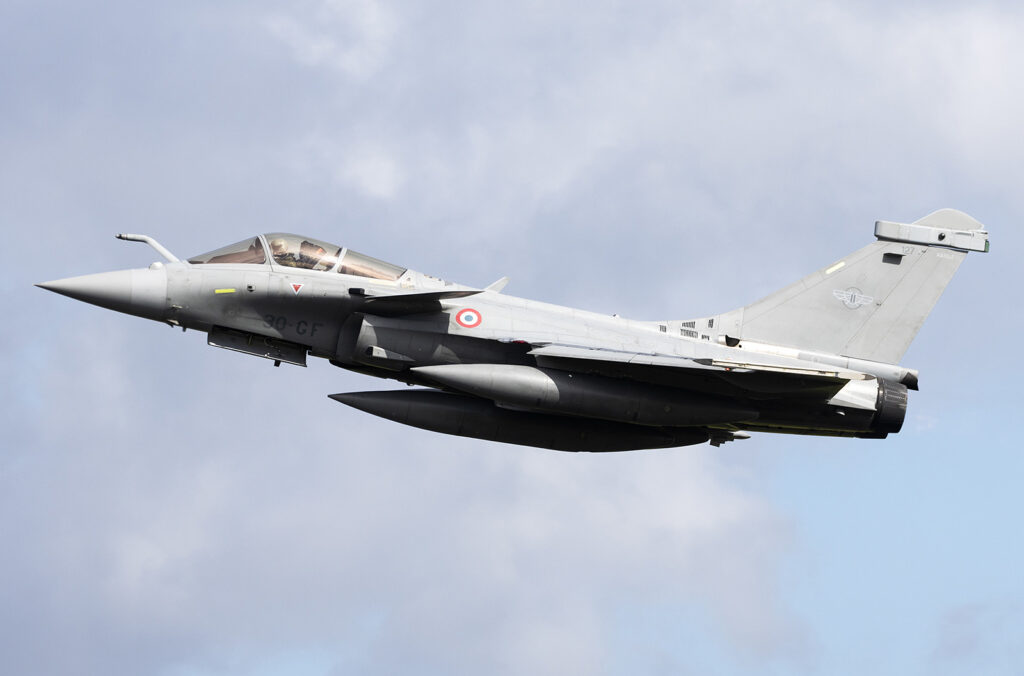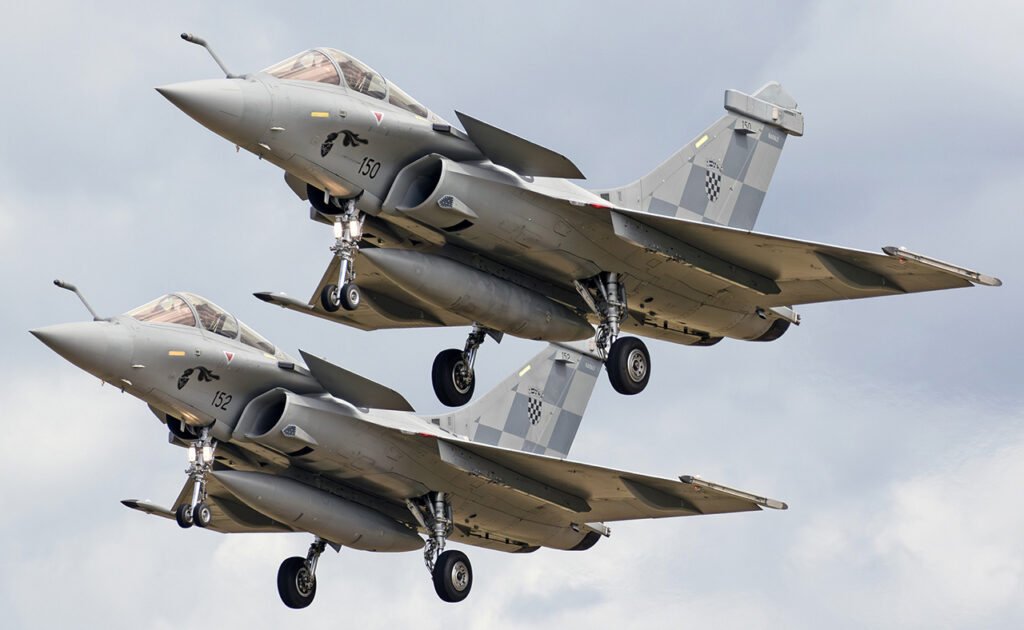Dassault Rafale: A multi-role fighter with twin engines, capable of air superiority, interdiction, and nuclear strike missions with advanced avionics.
In brief
The Dassault Rafale is a 4.5-generation multi-role fighter aircraft developed by France’s Dassault Aviation. It features two Snecma M88-2 engines, providing a maximum speed of Mach 1.8 and a service ceiling of 50,000 ft (15,240 meters). The aircraft has a combat range of 1,150 miles (1,850 km) and a maximum takeoff weight of 24,500 kg (54,013 lbs). It is equipped with advanced avionics, a glass cockpit, and a variety of weapons systems, allowing for air-to-air, air-to-ground, and nuclear missions. First flown in 1986, it has seen extensive operational use in various conflicts worldwide.

The Dassault Rafale fighter jet
The Dassault Rafale’s development began during a period of significant change in the European aerospace industry. The 1970s saw the proliferation of advanced aircraft designs across the NATO nations, and there was a pressing need for France to modernize its air force. During this time, the French military sought an aircraft capable of performing multiple roles in one platform—air-to-air, air-to-ground, and nuclear strike—reducing the logistical burden of maintaining multiple aircraft types. Additionally, France aimed to develop an indigenous solution to avoid reliance on foreign suppliers for such a critical defense asset.
By the late 1970s, several European nations, including France, Germany, the United Kingdom, and others, explored the possibility of jointly developing a next-generation fighter. This led to the formation of the Future European Fighter Aircraft (FEFA) program. However, France’s requirements, particularly its focus on carrier operations and nuclear strike capabilities, diverged from those of its partners. In 1985, France officially withdrew from the joint effort to pursue its national fighter, leading to the birth of the Dassault Rafale program.
The Rafale was intended to replace several older aircraft in the French Air Force and Navy, such as the Dassault Mirage 2000, the Super Étendard, and the F-8 Crusader. The goal was to field a versatile and technologically advanced aircraft that could operate in multiple environments, including land-based and carrier-based operations. This approach was also intended to reduce operational costs, as one aircraft type would replace many.
The Rafale first flew on July 4, 1986, marking a significant milestone in French aviation history. The prototype demonstrated the viability of the design, which featured a delta wing and canards for enhanced maneuverability. The aircraft’s name, Rafale, means “gust of wind” in French, symbolizing its agility and speed. Although the aircraft is primarily known by its French designation, it does not have a NATO nickname.
By the 1990s, the Rafale entered a competitive global market for fighter jets, facing off against aircraft such as the Eurofighter Typhoon, the American F-16 Fighting Falcon, and the Russian Su-30. The Rafale distinguished itself with its ability to perform in both air-to-air combat and air-to-ground attack roles, coupled with its advanced electronic warfare capabilities. Unlike many of its competitors, the Rafale was designed with nuclear deterrence in mind, a reflection of France’s independent nuclear strategy.
Design of the Dassault Rafale
The Rafale’s design is centered on versatility and high performance across a range of missions. Its airframe is constructed from a combination of composite materials, aluminum-lithium alloys, and titanium, contributing to a reduced radar cross-section (RCS). While not a true stealth aircraft like the American F-22 Raptor, the Rafale’s reduced RCS makes it harder to detect by enemy radar systems compared to earlier generation fighters.
The aircraft has a delta-wing configuration combined with canards. This design choice enhances its agility, particularly at high angles of attack, providing superior maneuverability in close combat. The canards, located near the cockpit, help to control airflow over the wings, improving lift during low-speed maneuvers and carrier landings. With a wingspan of 10.90 meters (35.8 ft) and an overall length of 15.30 meters (50.2 ft), the Rafale is compact enough for carrier operations, a key requirement of the French Navy.
A significant advantage of the Rafale is its modular avionics architecture. This allows the aircraft to integrate various weapon systems and sensors depending on the mission requirements. The cockpit features a glass layout, with touchscreen displays providing the pilot with a wealth of information at a glance. The pilot’s helmet is also equipped with a Heads-Up Display (HUD) that projects critical data, enhancing situational awareness. These systems are supported by the Thales RBE2 radar, which is capable of detecting multiple targets at long ranges, both in the air and on the ground.
While the Rafale’s design provides excellent maneuverability and adaptability, there are some drawbacks. For example, its lack of true stealth capabilities makes it more vulnerable to detection compared to 5th-generation fighters like the F-35. Additionally, its airframe, though designed for carrier operations, imposes certain limits on payload capacity compared to land-based fighters that are not restricted by carrier compatibility requirements.
However, the Rafale excels in multirole capability. It can carry out reconnaissance, nuclear deterrence, and conventional strike missions, all while maintaining air superiority in contested environments. The flexibility in its design allows for the integration of a wide variety of weapons, including precision-guided munitions, cruise missiles, and air-to-air missiles, making it a formidable platform for modern warfare.
Performance of the Dassault Rafale
The Rafale is powered by two Snecma M88-2 turbofan engines, each capable of delivering 50 kN (11,250 lbf) of dry thrust and 75 kN (16,900 lbf) with afterburners. This gives the aircraft a maximum speed of Mach 1.8 (2,223 km/h or 1,381 mph) at altitude. The engine is designed for high performance while maintaining low fuel consumption, allowing the Rafale to fly longer missions without the need for frequent refueling.
The aircraft has a combat radius of 1,850 kilometers (1,150 miles), allowing it to perform extended operations deep within enemy territory. With a maximum takeoff weight of 24,500 kg (54,013 lbs), the Rafale can carry up to 9,500 kg (20,944 lbs) of external stores, including fuel tanks and weapons. The aircraft’s service ceiling is 50,000 ft (15,240 meters), providing it with the altitude advantage over most adversary aircraft.
Compared to its competitors, the Rafale stands out for its adaptability. The Eurofighter Typhoon, for example, excels in air-to-air combat but lacks some of the Rafale’s air-to-ground and multirole capabilities. Similarly, while the American F-16 offers excellent maneuverability and combat effectiveness, it lacks the range and payload flexibility of the Rafale. The Russian Su-30, on the other hand, is a larger and heavier aircraft, offering greater range but less agility and multirole versatility.
Variants of the Dassault Rafale
The Dassault Rafale has three primary variants, each tailored for specific operational environments. The Rafale C is the single-seat version designed for the French Air Force. It retains all of the multirole capabilities, from air-to-air to nuclear strike, and is optimized for land-based operations.
The Rafale M is the carrier-based variant, designed for the French Navy. It features a strengthened undercarriage, an arrestor hook for carrier landings, and is equipped with a carrier-specific landing system. The Rafale M can operate from smaller carriers, like the French Charles de Gaulle, giving the Navy a versatile air superiority and strike platform at sea.
The Rafale B is the twin-seat version, primarily used for training and specialized missions. It can also be equipped for combat roles, particularly in air-to-ground strike missions that benefit from a second crew member for managing complex sensor and weapons systems.

Military use and combat of the Dassault Rafale
The Rafale has been involved in numerous military operations since its introduction into service. One of its first combat roles was during Operation Serval in Mali in 2013. The Rafale provided close air support for ground forces, using precision-guided munitions to neutralize enemy targets. Its versatility allowed for rapid switching between air superiority and ground attack roles, showcasing its multirole capabilities.
During Operation Chammal, part of the international coalition against ISIS in Iraq and Syria, the Rafale played a crucial role. The aircraft conducted airstrikes against key ISIS positions, targeting command centers, infrastructure, and supply lines. The Rafale’s ability to operate in contested airspace with advanced electronic warfare systems allowed it to evade enemy radar and surface-to-air missiles.
The Rafale has also been exported to several countries, including Egypt, India, and Qatar. In 2015, Egypt became the first foreign operator of the Rafale, followed by Qatar in 2016. India’s acquisition of 36 Rafale jets was a significant boost to its air force capabilities, particularly for its contested border regions.
The aircraft remains in service with the French military, with plans for continued upgrades to its avionics and weapons systems. As of now, the Rafale has not been replaced in its key roles, and future variants are expected to keep the aircraft relevant in modern combat scenarios.
Back to the Fighter Jet section.